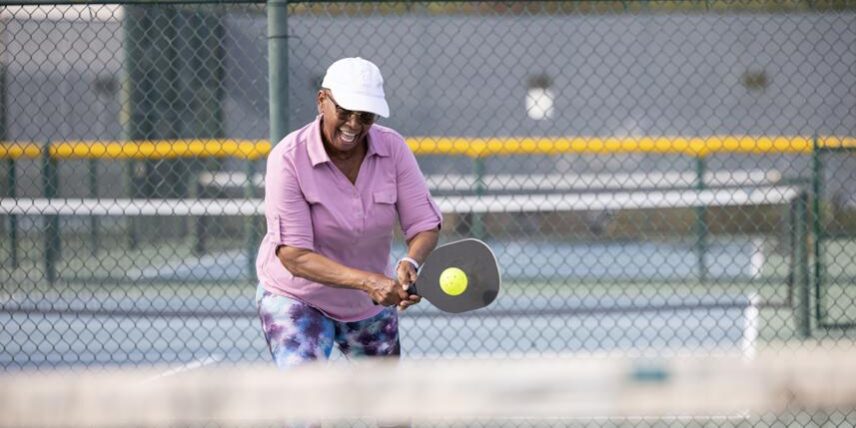Physical activity is always good for the brain. But improving your hand-eye coordination can be even better. Here’s why.
If you’ve ever played catch with a child, you’ll be familiar with hand-eye coordination. That’s your brain’s ability to process the visual of that ball soaring toward you, then signal your arms and hands to catch it.
But hand-eye coordination isn’t just about how well or fast you see things or move your hands. Many of the things we do every day — getting dressed, making lunch, driving a car, even picking up an object — involve our eyes and hands working well together.
Hand-eye coordination is something that starts to decline as you get older. That’s when your reaction times may begin to slow down — and maybe you miss a couple of the throws. Losing this skill can have a negative impact on your quality of life and, eventually, your independence.
“Poor eye-hand coordination can lead to impairment in activities of daily living, including eating and drinking, sewing and knitting, cooking and cleaning, and driving,” says Andrew Lee, M.D. He’s a clinical spokesperson for the American Academy of Ophthalmology and a neuro-ophthalmologist at Houston Methodist Hospital.
Your brain health matters!
BrainHQ rewires the brain so you can think faster, focus better, and remember more. And that helps people feel happier, healthier, and more in control. Sign up today!
So, what do you need to know to keep your brain sharp and your hand-eye coordination at the top of its game? Find out below.
How hand-eye coordination helps your brain
Physical activity is a quadruple threat (in a good way!). It can help prevent dementia and other brain health issues. And it enhances your:
- Cardiovascular system (i.e., your heart)
- Cognition (how well your brain works)
- Coordination (so you’re less likely to fall and injure yourself)
Exercise can help you think, learn, and problem-solve, too, according to the Centers for Disease Control and Prevention. And a study in the journal Preventive Medicine found that inactive adults ages 45 and older are nearly twice as likely to experience cognitive decline than those who regularly get moving.
But sports and activities that specifically involve hand-eye coordination are even better for the brain. When you have to coordinate what you see with what you do, your brain has to work hard, transforming inputs from your eyes (like seeing a ball coming your way) into the right output at the right time (like swinging your racket).
This brain work is really a form of brain training — asking your brain to be fast and accurate, and to make the right decision at the right moment.
Never been a natural athlete? Don’t let that stop you. “Practice makes perfect, and practicing any task — regardless of age or disability — can improve the speed and accuracy of visual-motor tasks,” says Dr. Lee.
Here are three types of activities that can help improve your hand-eye coordination. Another plus: New activities may also help your social life, which is another easy way to engage your brain and keep it sharp.
1. Pickleball
If you haven’t already tried this paddle sport — sometimes described as a combination of Ping-Pong, tennis, and badminton — it may be time to pick it up. Pickleball has become the fastest growing sport in the U.S., nearly doubling in popularity in 2022.
Keeping your eye on the ball and hitting it back over the net is an ideal example of your hands and eyes working together. This improves depth perception, movement, and balance.
Pickleball may also help boost your brain in a different way: by improving your mood. According to a study in the journal Leisure Studies, older adults who play pickleball are less likely to suffer from depression.
Plus, the courts are smaller than those for tennis, but the balls are bigger. In other words, there is no excuse not to give it a good whack.
Want to keep it more old school than pickleball? Try your hand (and eye) at its smashing older cousin, Ping-Pong, to reap similar brain benefits.
Pickleball courts are popping up everywhere. To find out where to play near you, type in your ZIP code on the USA Pickleball Association website.
2. Tai chi
Tai chi is an ancient Chinese practice that involves a series of slow gentle movements, meditation, balance exercises, and controlled breathing. A study in the journal Disability and Rehabilitation found that doing tai chi three times a week for three months improved hand-eye coordination by nearly 20%.
Tai chi may also have a positive effect on your cognitive function. According to a study in Clinical Interventions in Aging, older adults in the early stages of dementia saw improved cognition after practicing tai chi for 30 to 60 minutes, three times a week, for three months. Visit the Tai Chi Foundation to find classes near you or online.
3. Gardening
If you like to be active but sports aren’t your thing, consider getting your green thumb in play instead. According to a study in the International Journal of Environmental Research and Public Health, older adults who participated in horticultural activities for two hours each week for eight weeks — including planting, weeding, watering, and picking up leaves — showed a significant improvement in hand-eye coordination.
Digging in the dirt is also associated with better brain performance. According to another study published in the same journal, gardening helps stimulate the growth of brain nerves in older adults that help improve or maintain cognitive function.
Don’t have a plot of your own? Consider volunteering with your local parks department or a community garden.
Other brain-sharpening activities
When you’re not up to getting too physical, there are other ways to give your hand-eye coordination a boost. Here are some options:
- Bouncing a ball
- Playing catch
- Playing video games
- Learning to juggle
“Be creative,” says Dr. Lee. “Take up a new hobby, such as painting or model building.” Get those hands and eyes working together, and enjoy yourself while you’re at it.
Yet another great option that you can do sitting down at your computer or on your smartphone? BrainHQ, a brain-training program designed by leading scientists that rewires the brain to help you think faster, focus better, and remember more. And it may be included at no cost with your Medicare Advantage plan. Check your eligibility today.
Additional sources:
Physical activity and cognition: Centers for Disease Control and Prevention
Pickleball: Sports & Fitness Industry Association
Table tennis: Encyclopedia
Tai Chi: National Center for Complementary and Integrative Health
Gardening and hand-eye coordination: International Journal of Environmental Research and Public Health







